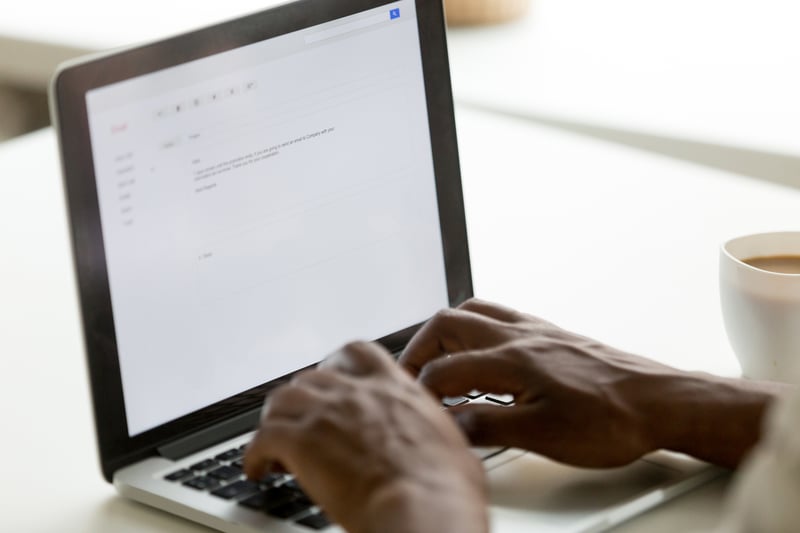
Gentle Reminder Meaning: How to Write a Sales Email that Gets Noticed
 Updated on
Updated on
By Ringy
Table of Contents
Table of Contents
A subtle reminder email is a method of politely messaging a prospect to move them along the sales pipeline.
This gentle reminder meaning article is written to inform you about one of the most overlooked forms of client retention. You aren’t the only one attempting to capture the awareness of people searching for your niche. Standing out from the multitude of gentle reminders sent every day is a challenging task.
Each day the average office worker receives over 100 emails, making it possible that your outreach message goes unnoticed. With over 80% of United States employees checking their business emails outside of working hours, it’s clear how seriously people take these digital messages.
A gentle reminder in email format is an excellent way to show the prospect your business's offerings. Providing the customer with more attention may persuade them to purchase your solution, therefore closing more deals.
This gentle reminder meaning article deep dives into what a subtle reminder's meaning and definition is to give you a greater understanding of the practice. By the end of this gentle reminder meaning blog post, you’ll know how to send a subtle reminder email, learn about the importance of a polite reminder message, and view examples of gentle reminders to implement into your own outreach efforts.
What Is a Subtle Reminder Email in Sales?

There are many scenarios where a person would utilize a gentle reminder email, such as for late assignments, highlighting unpaid expenses, or confirming attendance at an approaching meeting.
A subtle reminder is sent in two ways:
- Prior to something occurring. A gentle reminder attached to a future event is a great way to keep employees updated with the company’s schedule.
- The failure of something past its expected due date is another excellent use case for a subtle reminder email. Think of an invoice that hasn’t been paid or content that wasn’t delivered on time by your creative team.
Sending a subtle reminder email has a single motive – to increase the prospect’s probability of taking action.
The actionable step might be paying for an invoice, sending required documents, or calling the business to book an appointment. It is essential to place a CTA (Call to Action) at the end of your gentle reminder to show the client what to do.
Writing a cold call follow up email is straightforward, yet multiple folks find them challenging to compose. Have you ever considered why this fact is true?
Dissimilar to a telephone or mobile interaction, emails are a passive form of communication, making them easier to ignore compared to a person-to-person call. That’s why you need to obtain specific skills for enterprise correspondence to succeed in business. The table below shows the advantages and disadvantages of a gentle reminder email.
|
Pros |
Cons |
|
Keep clients informed regarding the company or product updates. |
May come off as too “salesy” if the copy is not correctly written. |
|
Helps keep customers in the marketing funnel. |
Could make some patrons unsubscribe from the mailing list if gentle reminders are sent too often. |
|
Allows organizations to showcase their awards, nominations, or previously completed jobs. |
Bragging in gentle reminder emails can scare people away. |
|
Email marketing is a relatively cheap form of outreach. |
Dealing with the wrong copywriter for your gentle reminder emails may lead to unsatisfactory results. |
Persuasive, polite, and professional is the foundation of any gentle reminder email. Taking these tones into account will produce results that any business owner would be proud of. Utilizing the appropriate attitude and a friendly demeanor in emails can alleviate the issues that present themselves on the medium.
By following these basic gentle reminder meaning article guidelines you can get more people to respond. However, equivocation, aggressiveness, and rudeness in an email will likely lead to it going unnoticed. A gentle reminder is a structured message that needs to be creative and harbors the reader’s attention.
The perfect way to follow up with someone not getting back to you is with a gentle reminder email.
Why Are Gentle Reminder Emails Important?

Our professional and personal livelihood benefits significantly when we have the ability to write subtle reminder emails. Electronic mail moves the business world, and rightfully so. There are over 300 billion emails sent daily to organizations, clients, and suppliers.
Corporate workers spend more than 30 days per year checking and responding to messages. The average office executive receives over 100 emails each day, and around 35% of that figure is found at the bottom of the inbox. Sometimes even vital congruity may go unread in these messages.
Never forget; overlooked emails can transform into lost sales!
However, not all recipients may be disregarding your messages on purpose. Spam filters often limit emails by segmenting them as junk, especially if they have files attached.
A few differences between a conventional and gentle email reminder exist. These characteristics separate the two forms of outreach, making them useful for different purposes. The table below shows the key differences between a gentle reminder and a traditional email.
|
Gentle Reminder Email |
Standard Email |
|
Uses a passive tone |
Utilizes an assertive or passive-aggressive tone |
|
Providers the reader with a subtle reminder |
Gives the person full instructions or information |
|
It is sent after an interaction with the company |
Informs the recipient of an upcoming event or guides them to an action |
A terrible gentle reminder email that is difficult to write, can be cumbersome to read. So keep your message succinct to hold the reader’s attention for longer. Two things are required from the receiver – read the message and reply to it. It’s that straightforward!
The Benefits of Writing a Subtle Reminder Email

Now that the importance of a gentle reminder email is clear, it’s time to break down some of the benefits more comprehensively. A gentle reminder has the power to change your life if implemented correctly.
These advantages are essential to a business’s success and form the basis of excellent outreach attempts.
Benefit #1 – Easier to Follow up on Stagnant Deals
Deals stuck in the sales pipeline not only affect potential earnings but also use salespeople’s energy which can be utilized for more important business tasks. With an intuitive mobile CRM (Customer Relationship Management) solution, it is easier to follow up on past transactions.
Benefit #2 – Reminders Are Great for Building Habits
A gentle reminder recorded in your personal notes, is a fantastic way to form a new habit. Using an online service or a smartphone’s calendar reminder feature can keep you on track to achieving your goals.
Here are three other ways a subtle reminder can benefit an individual’s personal and professional life:
- Increases productivity
- Cultivates personal awareness
- Motivates people to get things done
Setting a gentle reminder on your cellphone or laptop allows you to forget about mundane tasks, while politely being prompted to take action when the time arises.
Benefit #3 – Spend Less Time on Calls
Phone calls are a form of passive-aggressive outreach and can often be a tedious process to follow. If a gentle reminder email is composed competently it can save sales teams or business leaders a massive amount of time. All company owners will tell you that time is money, and this statement rings true today more than ever.
Benefit #4 – Avoids Disruptions
Avoiding disruptions is a key component of an excellent sales marketing strategy. If you’re in the middle of a conversation with a client, disturbing the service to answer another call is not a good customer support practice. Implementing a CRM system with SMS and email reminders also benefits patrons by preventing interruptions when returning messages.
Moreover, your clients won’t be disrupted by a phone call during their workday, so it’s a win-win for both parties.
Benefit #5 – Helps Develop a Solid Customer Relationship
Building client loyalty and instigating repeat business is easier with subtle reminders. Please remember that relationship building is a two-way street that requires patience and perseverance on behalf of the marketer.
SMS and email reminders help create reliable, consistent client services for your patrons while requiring minimal effort from you!
Other Benefits of Gentle Reminder Emails
Besides the advantages mentioned above, there are other benefits businesses receive from sending gentle reminders. These include but are not limited to:
- The ability to track and monitor opened or unopened emails
- It’s an excellent way to retarget website visitors
- Emails can be personalized to suit the buyer’s persona
Taking full advantage of this form of communication is an incredible way to boost overall business exposure and customer satisfaction.
How to Write an Effective Gentle Reminder Email

Things tend to slip the minds of even the most punctual humans, meaning your potential customers aren’t an anomaly. So if you have sent a gentle reminder email or message that ticks all the subtle outreach requirements, it shouldn’t exasperate the prospect.
Once a gentle reminder is sent, you can monitor analytics to see if the client ignored or opened the message. Various email marketing KPIs (Key Performance Indicators) aid in measuring and tracking the performance of online customer correspondence.
You may be contemplating, “How do I write a subtle reminder email that won’t annoy my prospect?” or “How do I grab my client’s attention without being too pushy?” Follow the steps below to create a winning gentle reminder message that’ll get more responses and hopefully close more deals.
Step #1 - Have a Succinct Subject Line
Over 45% of recipients base their opening decision on the subject line of a gentle reminder sales email. Moreover, more than 65% of people move emails to the spam folder based on what’s written in the subject line.
It’s essential to include these attributes in a subject line if you wish to improve the click-through rate of a gentle reminder email:
- Shouldn’t include unnecessary words like "Thank you" or "Hello"
- Must be focused and simple
- Should be relevant to the content of email
- Must be concise
Have a look at email subject line tutorials for tips on writing a compelling sentence that’ll make your readers want to open the message.
Step #2 – Greet the Client Correctly
The importance of a salutation should not be waivered in a gentle reminder addressing a client. Most sales representatives tend to greet the prospect in the second or third message.
However, it's critical to begin the message in a polite, thoughtful, and courteous manner.
Start your gentle reminder emails with a salutation like:
"Dear Michael."
If you have built a solid relationship with the client, you can utilize “Hi” in front of their name to make the greeting more personal. Try not to use these three amateur welcoming texts:
- To whom it may concern.
- Hey there!
- Good day my friend!
Not only will this make you look nonchalant, but could rub the prospect up in the wrong way too.
Step #3 – Write a Compelling Main Message
A main message is the primary focus of a gentle reminder because you want the prospect to read and engage with it. Ensuring that the email is simple and concise is the core element to producing consistent results. Follow these three steps to write a compelling main message:
- Explain the reason for the mail (why)
- Excite the reader with your offer (what)
- Lay out a call to action (how)
Long-form emails consume too much time and are often removed from the client’s important message list. Being direct and humble in your tone is an excellent way of showing the customer their time is valued.
Step #4 – Begin with the End in Mind
The way an email ends is as important as it begins. You may encounter issues on the day a meeting is arranged with a prospect. Mitigate this problem by providing them with your phone number or a means of rescheduling the appointment.
Another way to make the person feel more comfortable is by assuring them the consultation can be postponed to their earliest convenience.
Step #5 – Utilizing a Professional Email Signature
Email signatures are an essential part of a gentle reminder, meaning these elements must NOT be overlooked. You can make a significant impact on prospects with an expert craft email autograph. There are plenty of online tools and signature generators that can help you make an awesome impression on clients.
Here are some things that should be avoided when creating an email signature to WOWs your prospects:
- Ignore phrases or long quotes that have nothing to do with your email signature
- Don’t add an email address to your mail autograph
- There should be no more than three or four lines of text in your digital identification stamp
By following this advice, you’ll avoid the embarrassment of looking unprofessional.
Providing Additional Information or Resources
When sending a gentle reminder, it's often helpful to go beyond simply stating the task at hand. Here's how:
- Including relevant details or attachments: If the recipient needs additional context to complete the task, include them in your email. This might be specific instructions, relevant documents, or links to helpful resources.
- Offering helpful resources or links for further assistance: Sometimes, people might need a quick refresher or additional guidance. Providing relevant links or offering to answer any questions demonstrates a willingness to help and ensures they have everything they need to succeed.
- Ensuring clarity and accessibility of information provided: Use clear and concise language. If including technical terms, consider adding brief explanations. This ensures everyone understands the information regardless of their background.
Formatting and Proofreading
A well-formatted and error-free email conveys professionalism and respect for the recipient's time. Here's how to achieve that:
- Using a clean and professional email format: Structure your email with a clear subject line, a concise greeting, a well-organized body, and a professional closing. To improve readability, utilize bullet points or numbering for lists.
- Checking for spelling and grammatical errors: Typos and grammatical errors can diminish the professionalism of your message. Utilize spell check and proofread carefully before sending.
- Reviewing the email for clarity and coherence: Read through the entire email with a critical eye. Ensure the message flows logically and the tone is appropriate for the recipient and situation.
5 Examples of Sales Gentle Reminder Emails

Every situation is different, that’s why writing friendly gentle reminders can be arduous. Take the time to understand your clientele before deciding which template is best. Below is a list of examples that can be used directly to save time.
Due Invoice - Gentle Reminder Email Template #1
Subject line: Your invoice was unable to be processed
Hello Mark
The due date for the invoice of your subscription has passed. It has been one week and we have tried to debit your account but to no avail. To avoid restrictions to your service, please make the payment as soon as possible.
Please let us know if you’re unable to make payment, as it’ll allow customer support to adjust your plan accordingly. If the invoice isn’t paid for within the next seven days, we’ll have to terminate your subscription.
Reach out if you are struggling to perform the required actionable steps.
Sincere Regards
Team Digi-TV
Meeting - Subtle Reminder Email Template #2
Subject line: Marketing team meeting this Monday
Hi Thomas
Please join us on Monday (1st October) for a meeting with our marketing team. We have created a comprehensive plan that considers your business’s needs.
Please utilize the Google Meets link below to hop on the call:
[Meeting link]
Best Wishes
George Trump
Sales - Gentle Reminder Email Template #3
Subject line: We have customized your offer!
Hi John
As per our last conversation, our sales team has made changes to the previous offer. You’ll now get the features you desire at the right price.
Please let me know if this fits your criteria and if we can proceed with the payment.
Kindest Regards
Susan
Late Deadline - Gentle Reminder Email Template #4
Subject line: Your assignment deadline has passed!
Hello Sarah
As per our company’s schedule, you have missed the assignment deadline by three days. The article was supposed to be received by 29 September, but nothings come in as of yet.
Can you let me know when the piece will be submitted? We have stringent deadline rules and would appreciate a swift reply.
Thanks
James Andersen
Flash Sale - Gentle Reminder Email Template #5
Subject line: Check out our specials before they’re sold out!
Hi Vanessa
Are you aware that The Clothing Shed is running a winter sale? You can receive up to 70% discount on all new and old cold weather clothing.
Don’t delay! Add your favorite items to the cart and enjoy massive savings today!
Ciao
The Clothing Shed Crew
Using one of these examples of gentle reminders can help you communicate with your clients better. Furthermore, it’s important to create a captivating subject line for your gentle reminder, as it should grab your prospect's attention. That’ll boost the message’s click-through rate and get more responses.
Do’s and Don’ts of Gentle Reminder Emails

Being aware of the dos and don’ts of a subtle reminder email is quintessential to successful gentle reminder content. Here lies a basic list of rules to follow when conjuring up your message:
|
Do This |
Don’t Do This |
|
Identify yourself |
Don’t sound like a radio or TV advertisement |
|
Offer a benefit |
Exclude special characters and symbols |
|
Ask a question |
Don’t be dishonest |
|
Use urgency and a CTA |
Avoid overusing numbers in your offers |
These instructions can help you tailor the perfect gentle reminder email that stands out from the crowd.
4 Subtle Reminder Email Templates
Here are four concise templates for crafting gentle reminder emails in various situations:
1. Polite Reminder Email to Boss
Subject: Quick Follow-up: [Project Name]
Hi [Boss's name],
Just a quick follow-up regarding the [Project Name] project. I wanted to check in and see if you have any updates or require any further information from me to move forward.
Thanks,
[Your Name]
2. Friendly Reminder for No Response
Subject: Checking In: [Original Email Subject]
Hi [Name],
I hope this email finds you well. I'm following up on my previous email about [briefly mention the topic]. I just wanted to see if you had a chance to review it and if you have any questions.
Thanks,
[Your Name]
3. Gentle Reminder for Meeting
Subject: Reminder: Meeting Today - [Meeting Topic]
Hi everyone,
This is a friendly reminder about our meeting today at [Time] to discuss [Meeting topic]. I'm looking forward to catching up and collaborating on [Briefly mention the goal of the meeting].
See you all soon!
[Your Name]
4. Subtle Reminder with Offer to Help
Subject: [Original Subject] - Just Checking In
Hi [Name],
I hope you're doing well. I'm following up on my previous email regarding [briefly mention the topic].
Is there anything I can do to help move this forward? Perhaps providing additional information or clarifying any points?
Thanks,
[Your Name]
FAQs
What would a gentle reminder meaning article be without a frequently asked questions section? Here you’ll learn about the most common queries business owners make when learning to compose a subtle reminder message.
What Type of Tone Is Used When Writing a Gentle Reminder Email?
A passive tone is best when composing a gentle reminder email. This tone of voice helps the recipient feel less pressured and makes them more susceptible to taking action.
Are There Downsides to Gentle Reminder Emails?
With all the positives there has to be some downsides, right? Well, the primary issue people have when writing a gentle reminder email is getting their tone correct. An aloof tone will not resonate with a client, especially if you’re looking to sell them something.
If a customer is addressed incorrectly or with too much haste, they may unsubscribe from your mailing list, leading to a lower retention rate in the business’s marketing funnel.
When Should I Send a Gentle Email Reminder?
A gentle mail reminder can be sent a few days after the initial email has been delivered. It helps to not be obnoxious or pushy during the early stages of communication with a new prospect. Not only will this lousy behavior scare them away, but it may affect the public’s overall opinion of your business.
Keeping lines of communication with your prospects open is key to improving the business’s sales closing rate.
Conclusion
Don’t get upset when a prospect doesn’t respond to your message! Instead, utilize a gentle reminder, meaning a mail that subtly garners the person’s attention. A best practice is to create and send a subtle reminder text when there has been no reply to the first email.
Increase the probability of your email being opened by sending more than one email reminder, but remember not to overwhelm the prospect too regularly.
You can make your life easier by using a CRM like Ringy to automate the gentle reminder email process. The platform allows you to call, text, or email your potential clients no matter where they are in the world.
Businesses love using Ringy for the analytical information it provides during the enterprise’s outreach efforts. Track your email and plan ahead intelligently with the software’s intuitive user interface.
We hope this gentle reminder meaning article has been informative and enlightening. Don’t you think it's time to increase your sales and improve your gentle reminder outreach efforts? What are you waiting for? Sign up for a demo and see what all the fuss is about!

Skyrocket your sales with the CRM that does it all.
Calling? Check. SMS? Check. Automation and AI? Check. Effortlessly keep in touch with your customers and boost your revenue without limits.

Take your sales to new heights with Ringy.
Sales in a slump? Ringy gives you the tools and flexibility you need to capture leads, engage with them, and turn them into customers.
Subscribe to Our Blog
Enter your email to get the latest updates sent straight to your inbox!
Categories
Related Articles



































































































